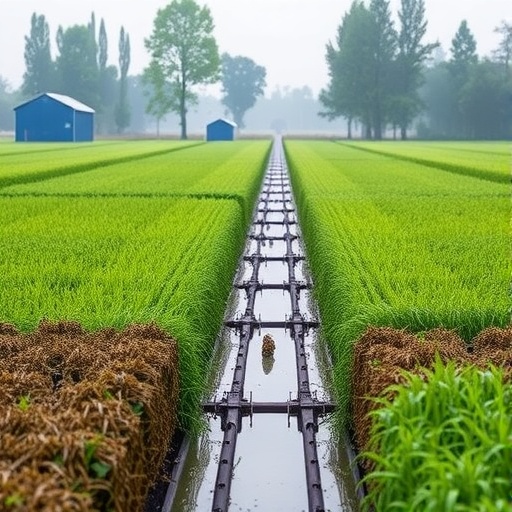
The agricultural sector worldwide faces increasingly complex challenges as climate change accelerates, directly influencing soil properties and crop productivity. Among these challenges, soil waterlogging has emerged as an insidious threat to global food security. Excessive soil moisture due to prolonged or intense rainfall events causes water to saturate the soil profile, depriving plant roots of oxygen and drastically altering physiological and biochemical processes within crops. Despite the substantial advances in agricultural modeling, current crop simulation models remain woefully inadequate in capturing the myriad effects of waterlogged conditions on crop performance, limiting their utility for forecasting and adapting to the changing environment.
Extensive analysis of twenty-one state-of-the-art crop models reveals glaring deficiencies in their ability to simulate crucial hydrological and plant physiological responses associated with waterlogging. A critical challenge lies in the accurate representation of capillary rise—a process where water moves upward from saturated layers towards the root zone through the soil’s pore spaces. This upward flux plays a pivotal role in determining the soil moisture available to crops during periods of excessive wetness or subsequent drying, yet it is frequently oversimplified or neglected outright in current models. The failure to incorporate nuanced soil-plant-water interactions compromises the predictive power of models under saturated soil conditions.
Beyond soil hydraulics, crops exhibit a range of adaptive mechanisms when confronted with transient or prolonged waterlogging events, yet these dynamic biological responses are rarely captured in simulation frameworks. Crop resistance to waterlogging involves complex physiological adjustments such as modifications in root morphology, altered stomatal behavior, and shifts in metabolic pathways aimed at mitigating hypoxic stress. Additionally, crops display recovery strategies post-waterlogging that influence yield trajectories significantly. The prevailing crop models typically overlook these temporal adaptations and recovery potentials, leading to substantial underestimations or oversights regarding crop resilience and productivity.
.adsslot_vcwZFdRe4D{width:728px !important;height:90px !important;}
@media(max-width:1199px){ .adsslot_vcwZFdRe4D{width:468px !important;height:60px !important;}
}
@media(max-width:767px){ .adsslot_vcwZFdRe4D{width:320px !important;height:50px !important;}
}
ADVERTISEMENT
The impact of waterlogged conditions extends beyond the plants themselves, deeply affecting soil nitrogen cycling processes. Saturated soils exacerbate denitrification rates, leading to elevated losses of soil nitrogen as gaseous emissions, thereby reducing the nitrogen availability for crops during critical growth stages. Simultaneously, nitrification processes slow under hypoxic soil conditions, further complicating nitrogen dynamics. Current modeling approaches inadequately represent these nitrogen fluxes and transformations, resulting in inaccurate simulations of plant nutrient uptake, growth, and ultimately, phenology and yield components.
Phenological development—the timing of developmental stages such as flowering and grain filling—is integral to yield outcomes under any environmental scenario. Waterlogging influences phenology by imposing stress that can accelerate or delay key phases depending on intensity and duration. The intricate hormonal signaling pathways mediating these responses are seldom considered in crop simulation platforms, contributing to gaps in predicting crop performance under waterlogged conditions. Without a holistic integration of these physiological and biochemical interactions, models lack the robustness to forecast yield losses or to inform irrigation and drainage management strategies effectively.
Yield components such as grain number, size, and biomass accumulation are direct outputs of complex interactions between soil moisture regimes, nutrient availability, and crop physiological responses. Excess soil moisture compromises carbon assimilation due to stomatal closure and root dysfunction, diminishes nutrient uptake, and disrupts assimilate partitioning. Current crop models often apply simplified yield functions that inadequately reflect the layered impact of transient waterlogging episodes. This simplification hinders the capacity to simulate yield variability under increasingly erratic climate patterns where waterlogging events are expected to become more frequent and severe.
The path forward necessitates a profound overhaul of crop modeling methodologies to integrate comprehensive soil-plant-atmosphere processes under waterlogged conditions. Advanced modeling analytics must extend to mechanistic representation of capillary rise, dynamic root-zone oxygen availability, and metabolic adjustments by crops in response to hypoxia. Inclusion of temporal dynamics describing crop resistance to stress and subsequent recovery are paramount for improving the fidelity of predictions. Furthermore, coupling nitrogen cycling biochemistry tightly with hydrological models will allow for the simulation of nutrient fluxes that align with observed soil and plant responses.
Addressing these modeling gaps will catalyze stronger scenario analyses capable of projecting future agricultural productivity in the face of climate volatility. Such enhanced tools will empower stakeholders—from researchers to policymakers and farmers—to devise targeted adaptation strategies. Effective adaptation may encompass modifying planting dates, introducing genetically waterlogging-tolerant cultivars, refining drainage infrastructure, or optimizing fertilizer applications to minimize nitrogen losses. Through iterative model improvements and validation against empirical datasets, simulation platforms can evolve into reliable decision-support systems that mitigate risks posed by soil waterlogging.
The urgency for sophisticated crop models grows as climate projections forecast increased rainfall variability, higher incidence of extreme weather events, and greater waterlogging prevalence. Without robust simulation tools, the agricultural community risks inaccurate predictions that could undermine food security initiatives, disrupt supply chains, and amplify vulnerability among smallholder systems. Investing in interdisciplinary research that bridges plant physiology, soil chemistry, hydrology, and computational modeling is critical to overcome current limitations.
Moreover, integrating high-resolution spatial and temporal data from sensors, remote sensing technologies, and field experiments will enrich model parameterization and validation. Machine learning and artificial intelligence methods hold promise in recognizing patterns and enhancing predictive accuracy amid the complexity of waterlogging impacts. Such hybrid approaches combining process-based models with data-driven techniques may offer a breakthrough in simulating nuanced crop-soil interactions under variable moisture regimes.
The implications of advancing waterlogging simulation extend to improving global assessments of climate change impacts on agriculture. Accurate models enhance our understanding of vulnerability hotspots and inform investment in resilient cropping systems. They also enable the evaluation of ecosystem services such as greenhouse gas emissions mitigation linked to soil moisture management, aligning agricultural productivity with sustainability goals.
Educationally, better models serve as platforms to train agronomists and farmers in recognizing and responding to waterlogging risks. Knowledge dissemination supported by credible simulation outcomes fosters adaptive capacity at grassroots levels, ensuring that predictive insights translate into tangible field practices. The democratization of advanced modeling tools through user-friendly interfaces and integration into precision agriculture frameworks will accelerate this transition.
In conclusion, the current landscape at the intersection of crop modeling and waterlogging is marked by significant knowledge and capability gaps. Identifying and addressing these through multidisciplinary innovation is imperative to safeguard crop yields in an era of climate uncertainty. The future of food security may well hinge on our ability to harness sophisticated analytic tools that unravel the complex interplay of soil moisture dynamics and plant physiological resilience. As research progresses, collaborative efforts across scientific domains will be key to developing robust models that empower sustainable agriculture worldwide.
Subject of Research: Modeling and simulation of waterlogging impacts on crop productivity, including soil hydrology, plant physiological responses, nitrogen cycling, phenology, and yield outcomes.
Article Title: Gaps and strategies for accurate simulation of waterlogging impacts on crop productivity.
Article References:
Garcia-Vila, M., dos Santos Vianna, M., Harrison, M.T. et al. Gaps and strategies for accurate simulation of waterlogging impacts on crop productivity.
Nat Food (2025). https://doi.org/10.1038/s43016-025-01179-y
Image Credits: AI Generated
Tags: adapting crop models for extreme weatheragricultural modeling limitationsagricultural sustainability and resiliencecapillary rise in soil processesclimate change impact on agriculturefood security challenges in agriculturehydrological responses in crop simulationsimproving predictive models for waterlogged conditionsphysiological effects of waterlogging on plantssoil moisture and crop productivitysoil-plant-water interaction complexitieswaterlogging effects on crops



